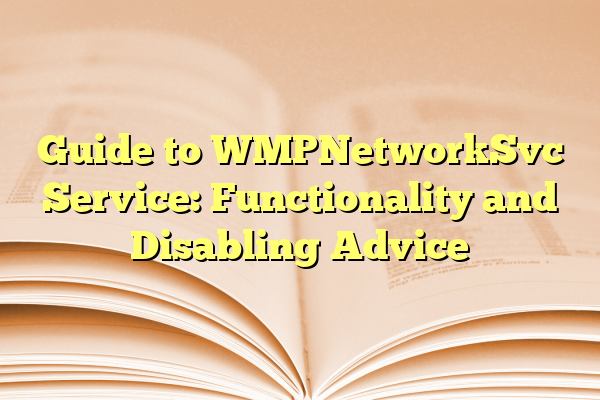
Guide to WMPNetworkSvc Service: Functionality and Disabling Advice
The WMPNetworkSvc service is a background process that comes bundled with Microsoft’s Windows Media Player. It operates as the Windows Media Player Network Sharing Service and plays a key role in enabling the sharing of media libraries across a network. While it may be useful in certain environments, especially for users who utilize media streaming in their household or office, the service can be unnecessary for others and may even impact system performance if left running without need.
Understanding what the WMPNetworkSvc does, and whether or not it should be active on your system, is important for maintaining a streamlined, efficient Windows environment. This guide outlines its function and offers informed advice on whether and how you might safely disable it.
Contents
What Is WMPNetworkSvc?
The WMPNetworkSvc stands for Windows Media Player Network Sharing Service. It allows Windows Media Player to:
- Share music, pictures, and videos with other computers or media devices on a network
- Communicate with UPnP and DLNA-compatible devices for home media streaming
- Automatically update media libraries across multiple devices
When enabled, this service monitors changes in the media library and transmits these updates to accessible devices on the same network. While its benefits become evident in media-rich networks, casual users rarely notice or use the features it enables.

Should You Disable WMPNetworkSvc?
Whether you should disable WMPNetworkSvc depends entirely on your usage. Below are the main considerations:
- High Resource Usage: On some systems, especially older or resource-constrained PCs, WMPNetworkSvc has been reported to consume a notable amount of CPU and memory resources even when idle.
- Security Concerns: Any service that transmits data over a network can potentially create vulnerabilities. If the service is not in use, disabling it reduces your network footprint and enhances security.
- Media Streaming Needs: If you stream files from your PC to smart TVs, gaming consoles, or other PCs, leaving this service on may be advantageous. However, if you never use Windows Media Player or media sharing functionalities, it’s likely safe to disable it.
Conclusively, for users who don’t use home media streaming, disabling this service can result in minor performance gains and fewer background operations.
How to Disable WMPNetworkSvc
Disabling the WMPNetworkSvc is safe if you’re certain it’s unnecessary for your workflow. Follow these carefully outlined steps:
- Press Win + R to open the Run dialog.
- Type
services.mscand press Enter. - In the Services window, scroll down to find Windows Media Player Network Sharing Service.
- Right-click on it and select Properties.
- In the Startup type dropdown menu, choose Disabled.
- Click Stop to halt the service immediately if it’s running.
- Click Apply and then OK to save your changes.
Once disabled, the service won’t restart unless manually re-enabled. This has no impact on basic media playback within Windows Media Player – only its sharing capabilities are affected.

Potential Issues After Disabling
Though disabling WMPNetworkSvc is generally safe, it’s important to be aware of what might change:
- Devices connected to your network may no longer have access to music or video libraries stored on your PC via Windows Media Player.
- Streaming via DLNA to devices like smart TVs or game consoles will not function unless the service is restarted.
These limitations only affect media-sharing tasks. If you are just playing music or videos locally on your PC, the service is unrelated and unnecessary.
Conclusion
In essence, WMPNetworkSvc serves a very specific function – facilitating multimedia sharing across local networks. For advanced users and media enthusiasts, it enables powerful features that smooth the experience of streaming content to multiple devices. However, for the vast majority of users, particularly those using other media players or streaming services, it represents a redundant background process that can be safely disabled.
It’s always important to evaluate which services are essential to your use case and to minimize background activity when security or performance is a concern. Disabling WMPNetworkSvc is a manageable way to lighten your system’s load — provided the features it supports are not part of your daily routine.
